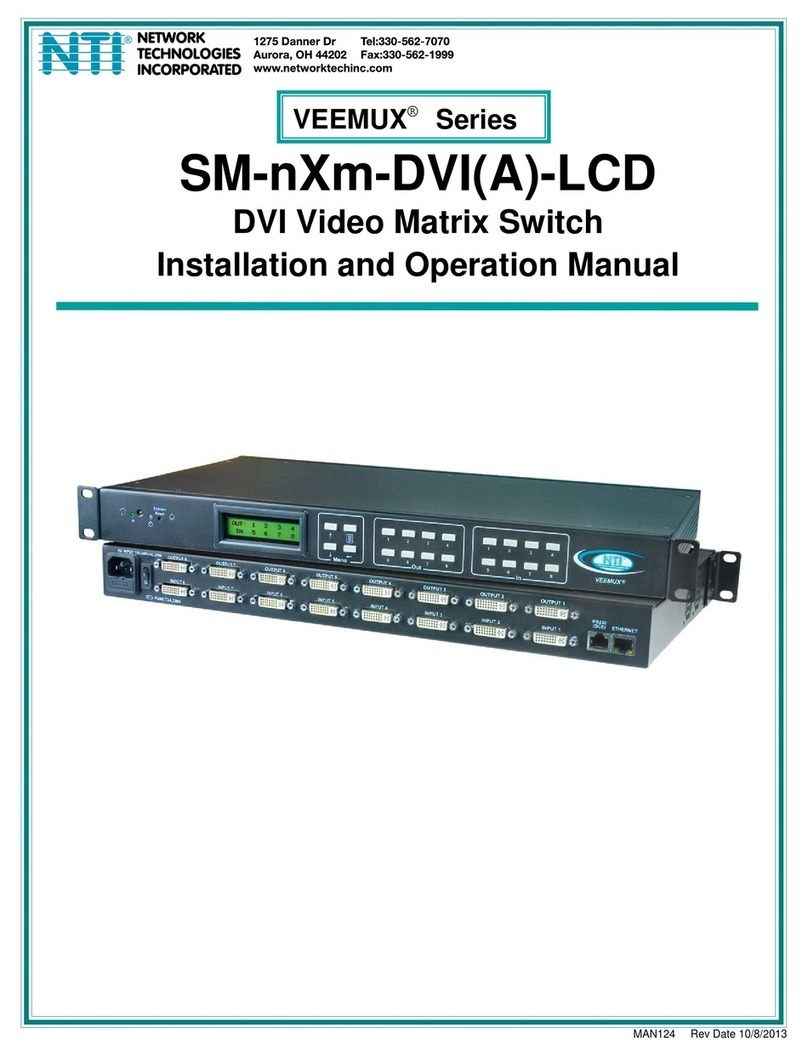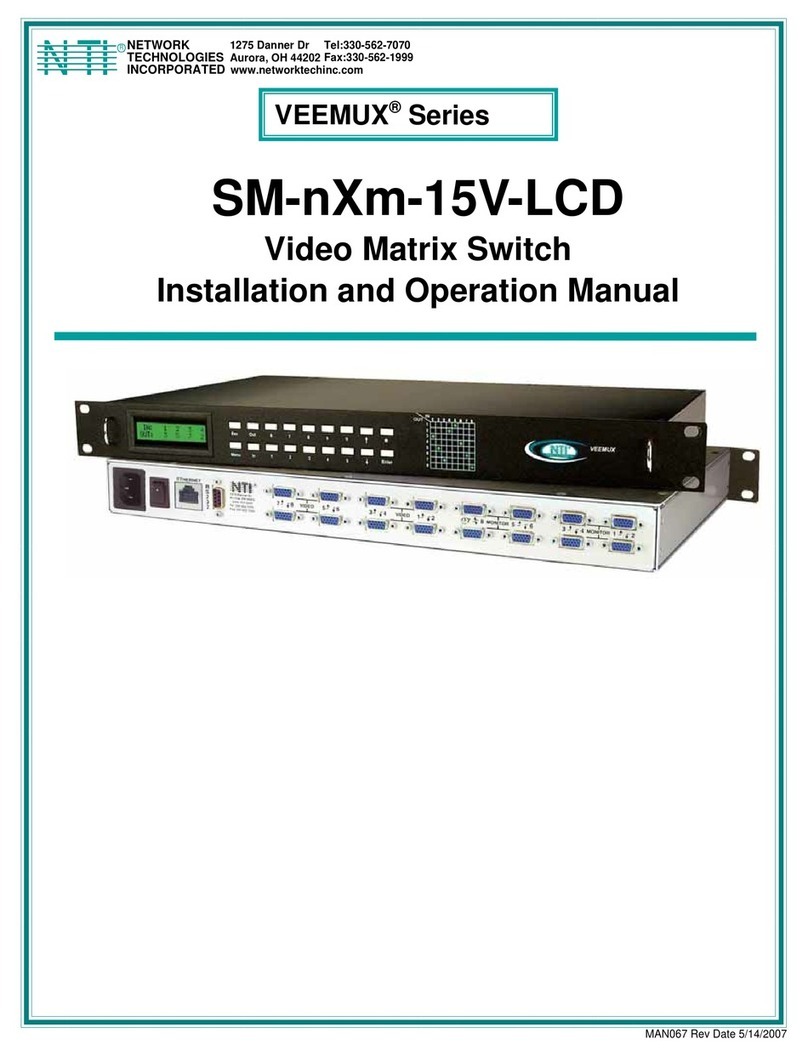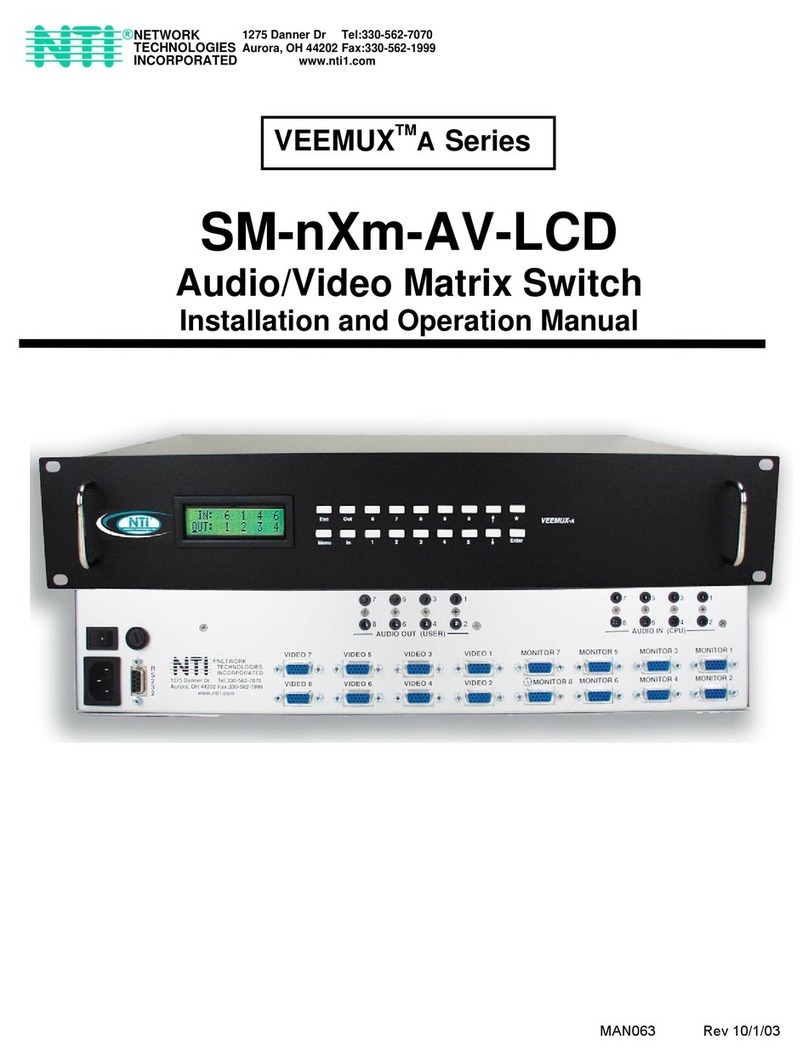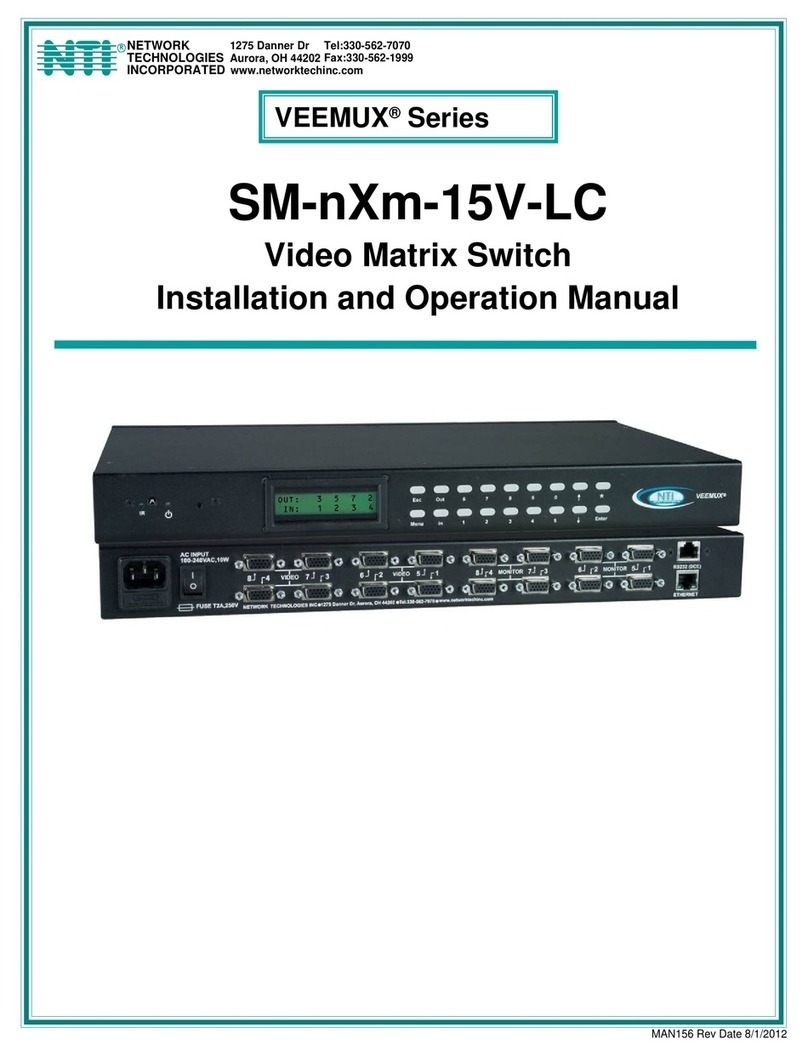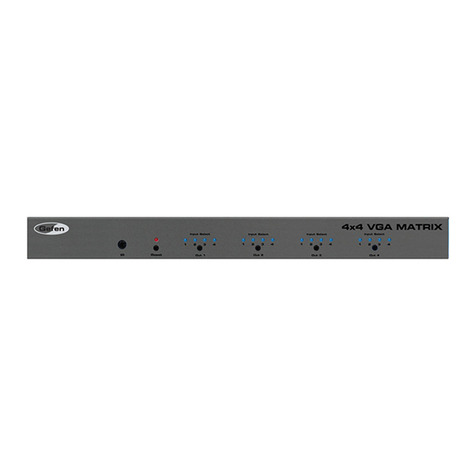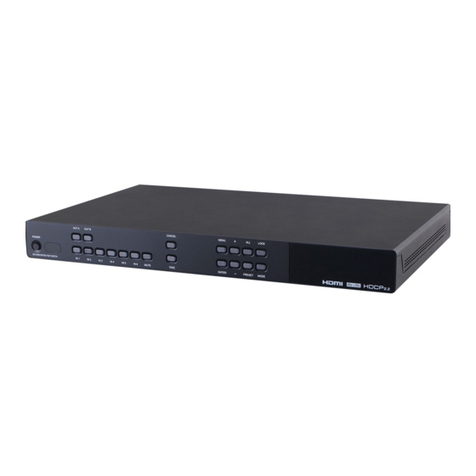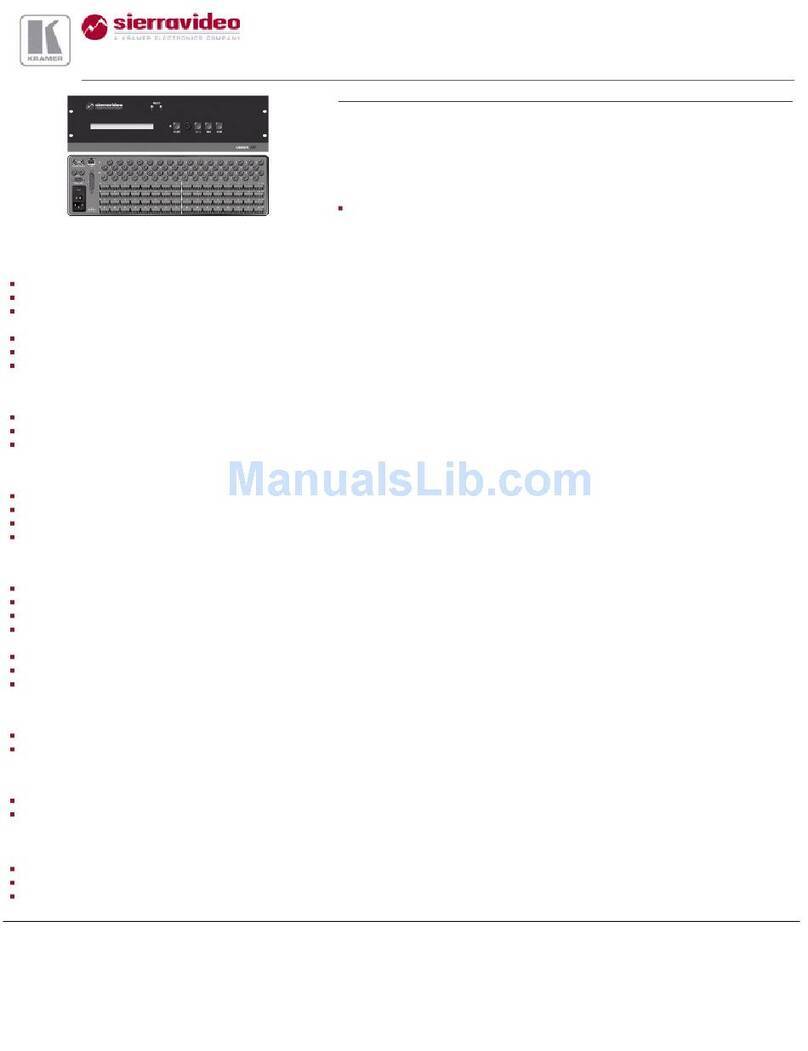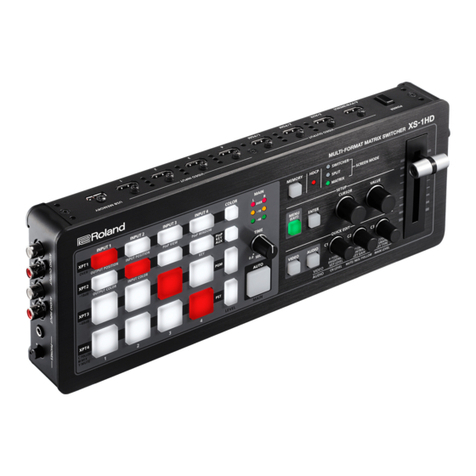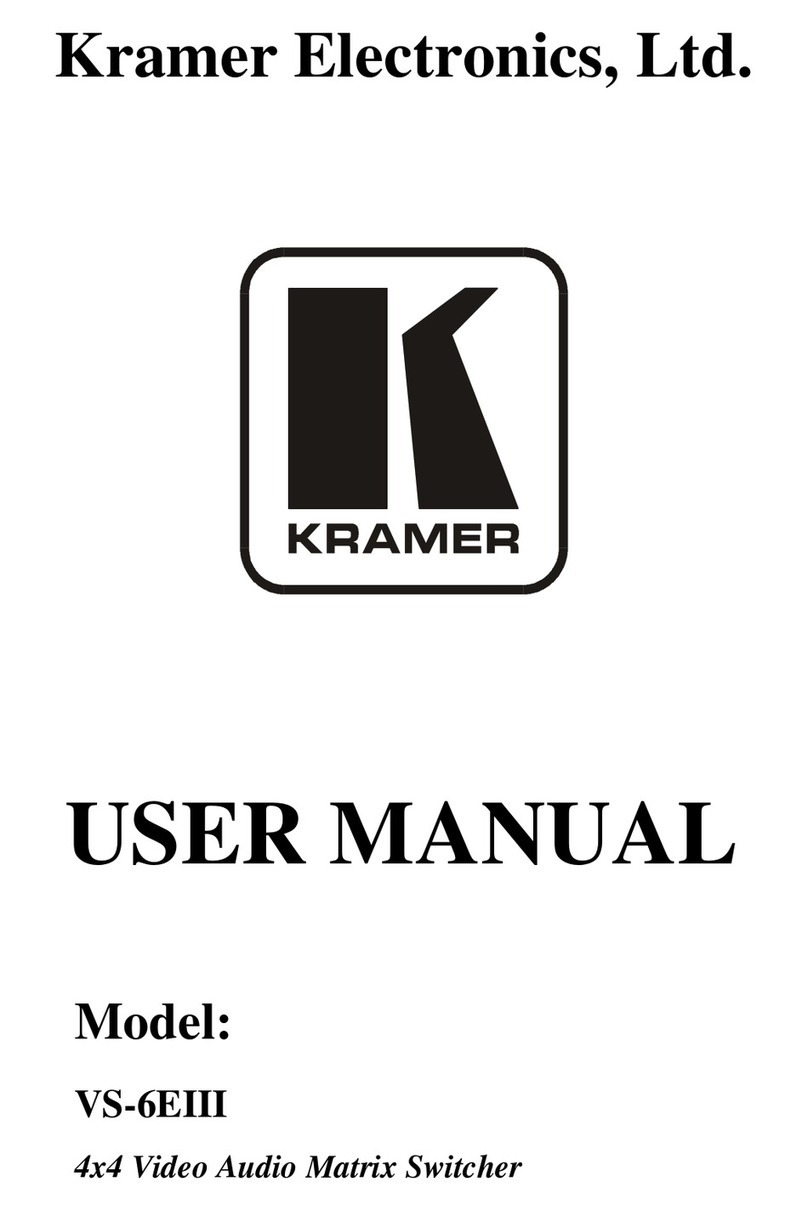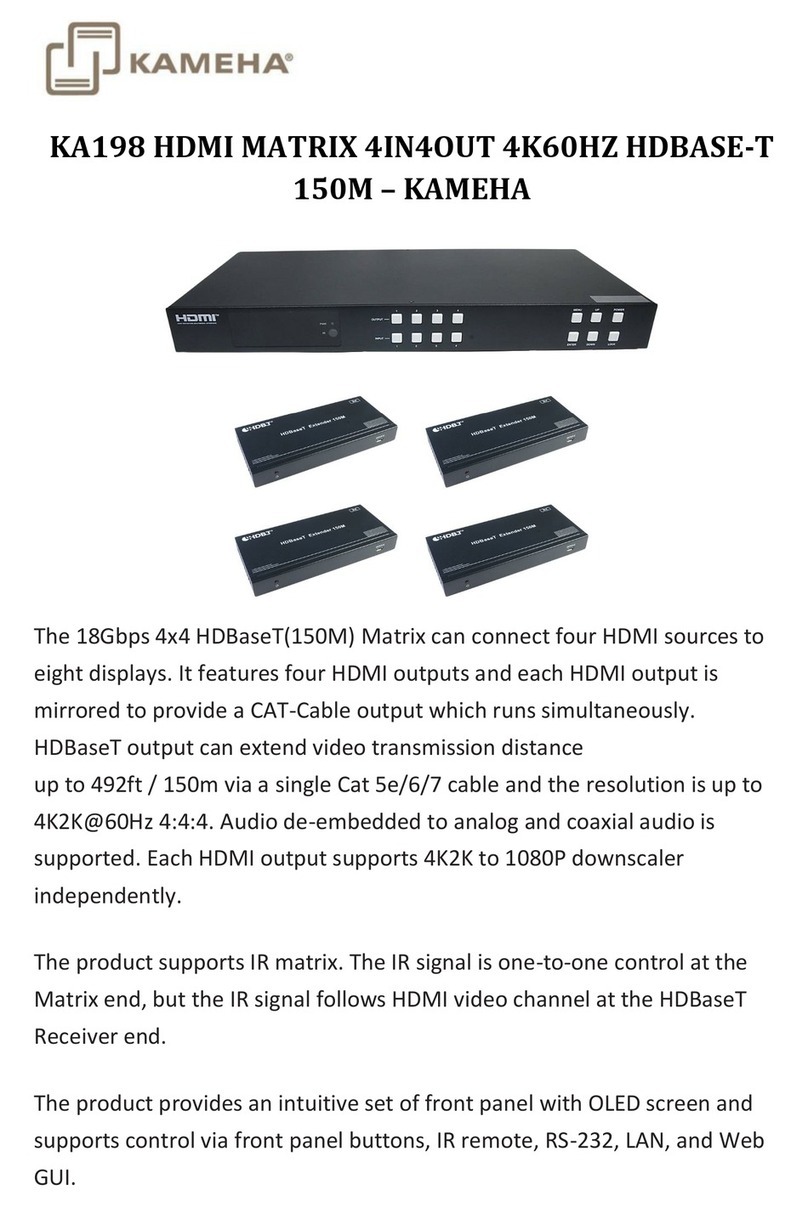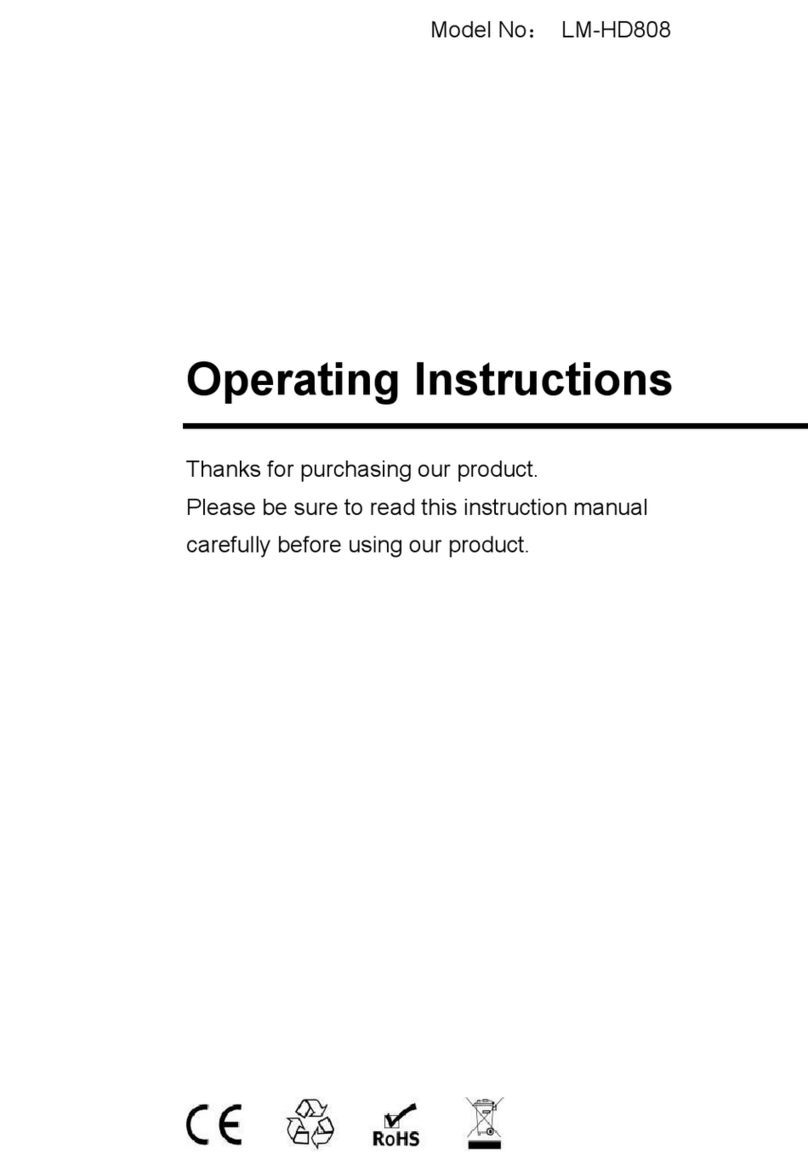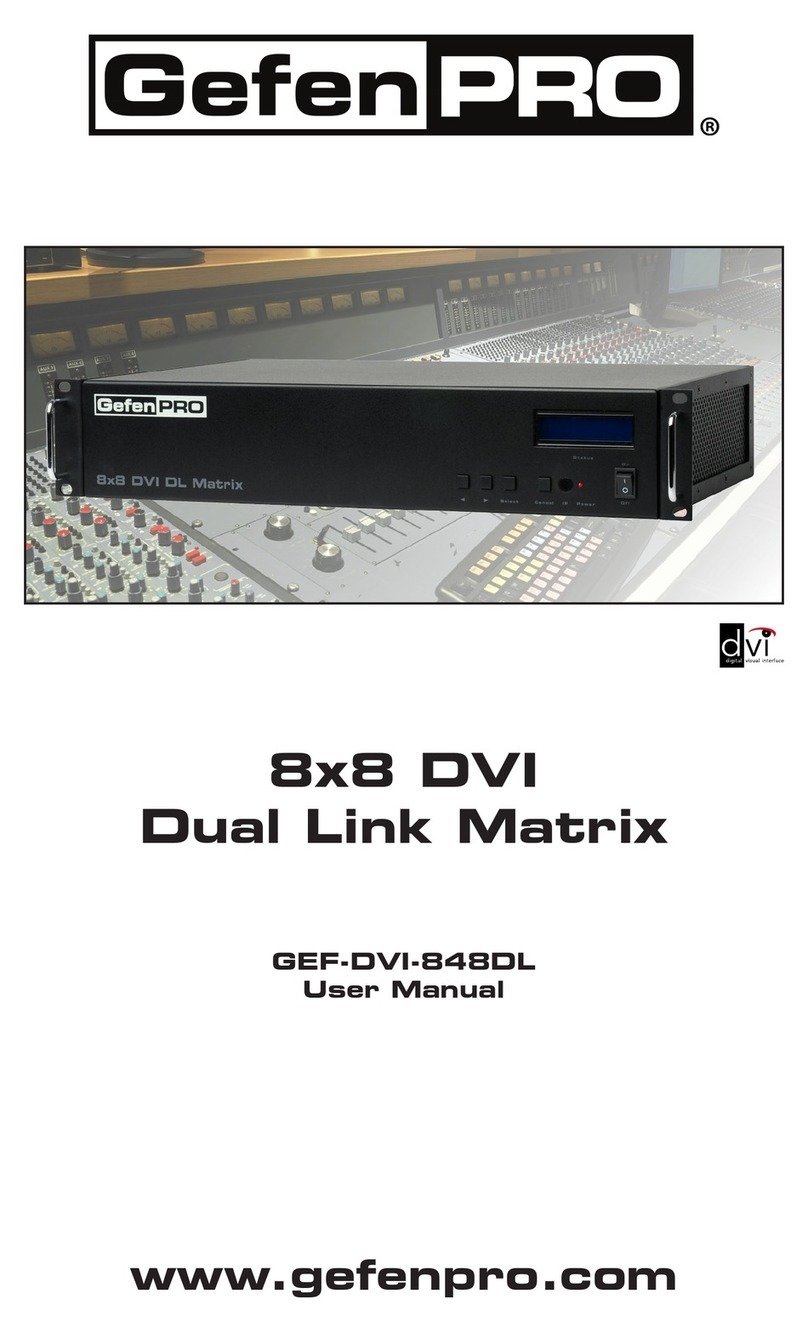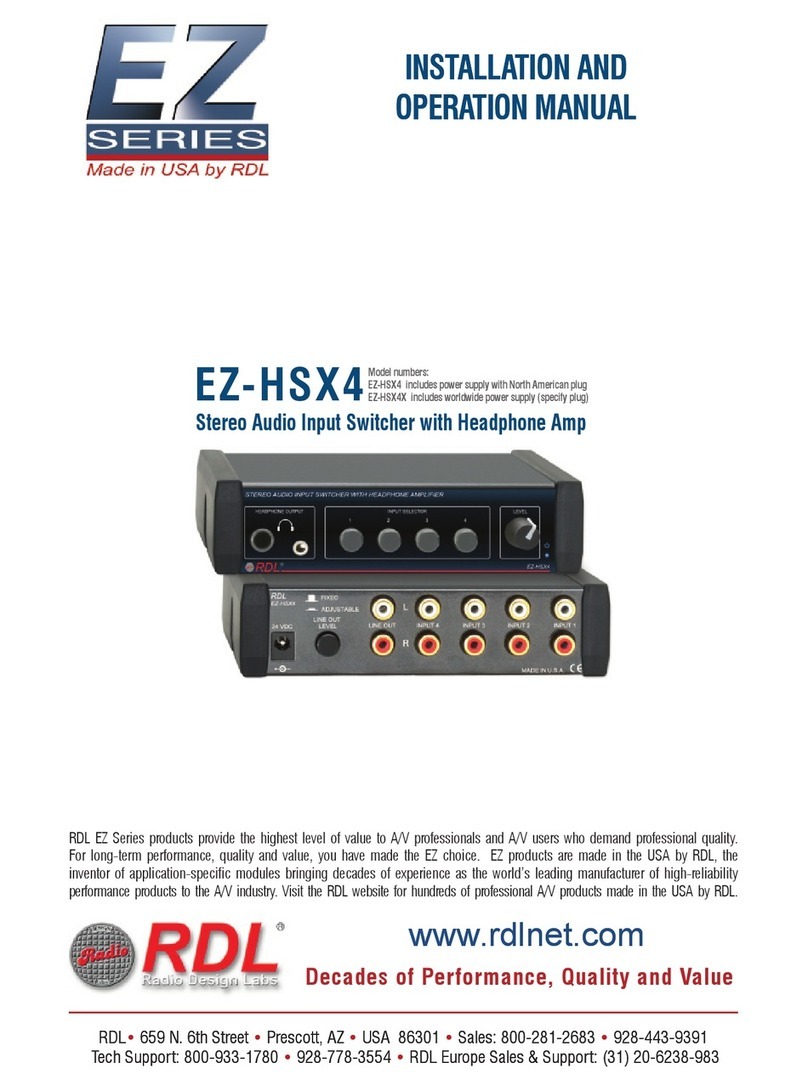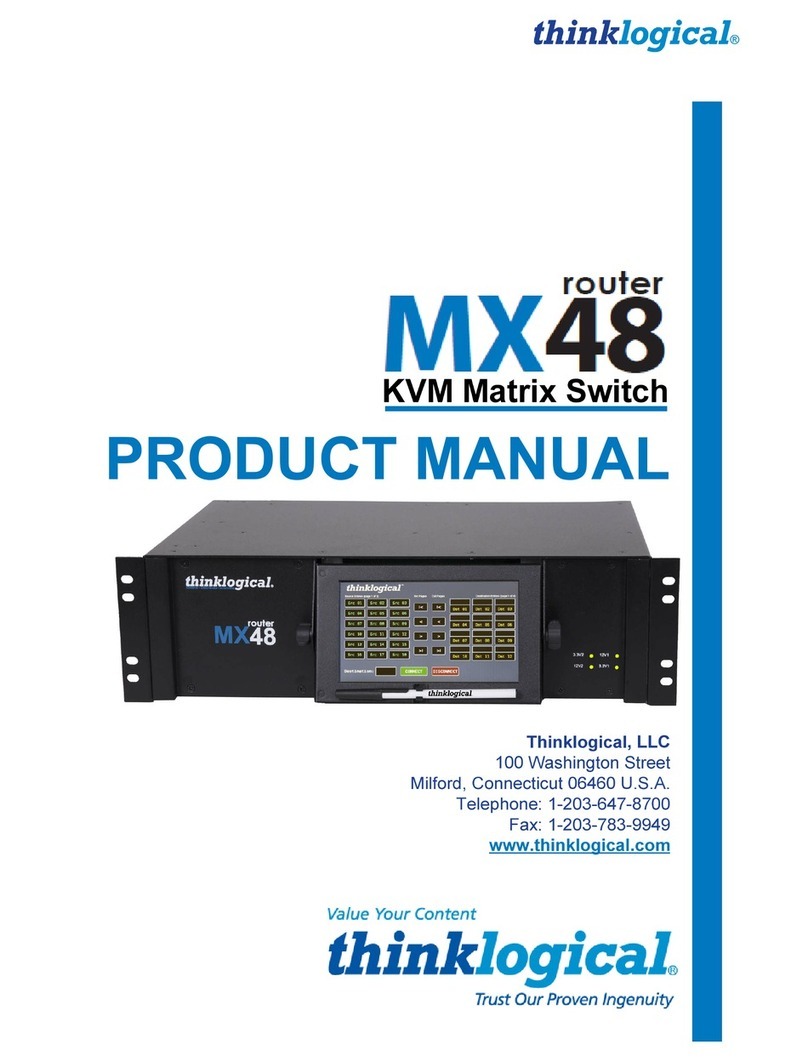Network Technologies SM-nXm-AV-LCD User manual

MAN069 Rev Date 7/19/2007
SM-nXm-AV-LCD
Audio/Video Matrix Switch
Installation and Operation Manual
V
EEMUX®
A
Series
NETWORK
TECHNOLOGIES
INCORPORATED
Tel:330-562-7070
Fax:330-562-1999
1275 Danner Dr
Aurora, OH 44202
www.networktechinc.com
NTI R

i
TRADEMARK
VEEMUX is a registered trademark of Network Technologies Inc in the U.S. and other countries.
COPYRIGHT
Copyright © 2002, 2007 by Network Technologies Inc. All rights reserved. No part of this publication may be reproduced, stored
in a retrieval system, or transmitted, in any form or by any means, electronic, mechanical, photocopying, recording, or otherwise,
without the prior written consent of Network Technologies Inc, 1275 Danner Drive, Aurora, Ohio 44202.
CHANGES
The material in this guide is for information only and is subject to change without notice. Network Technologies Inc reserves the
right to make changes in the product design without reservation and without notification to its users.
SOFTWARE VERSIONS
Front Panel LCD Software Version 1.2
Ethernet Control Software Version 1.16

ii
TABLE OF CONTENTS
Introduction.................................................................................................................................................................... 1
Basic Operation ........................................................................................................................................................... 1
Supported Web Browsers............................................................................................................................................ 1
Ordering Information.................................................................................................................................................... 1
Optional Features ..................................................................................................................................................... 1
Materials ...................................................................................................................................................................... 2
Cables.......................................................................................................................................................................... 2
Default User Name and Passwords ............................................................................................................................ 2
Features and Functions................................................................................................................................................ 3
Installation...................................................................................................................................................................... 4
Connect the Sources ................................................................................................................................................... 4
Connect the Monitors and Speakers ........................................................................................................................... 5
Connect RS232 ........................................................................................................................................................... 5
Connect to the Ethernet............................................................................................................................................... 6
Power Up ..................................................................................................................................................................... 6
LED Matrix...................................................................................................................................................................... 6
Control Options ............................................................................................................................................................. 7
Front Panel LCD with Keypad Control......................................................................................................................... 7
Making Connections ................................................................................................................................................. 7
Volume Control ......................................................................................................................................................... 8
Memory Functions .................................................................................................................................................... 8
Menu Button.............................................................................................................................................................. 9
Scan Mode................................................................................................................................................................ 9
RS232 Control.............................................................................................................................................................. 10
Remote Connection ................................................................................................................................................... 10
Baud Rate ............................................................................................................................................................... 10
Unit Address ........................................................................................................................................................... 10
Command Protocol .................................................................................................................................................... 11
Autostatus............................................................................................................................................................ 12
Matrix Switcher’s Control Program For Windows 9X, NT, 2000, XP and Vista ........................................................ 13
SerTest- RS232 Interface Test Program ................................................................................................................... 13
Main Options........................................................................................................................................................... 13
Matrix Operations.................................................................................................................................................... 13
Ethernet Operations................................................................................................................................................ 14
Setup Options ......................................................................................................................................................... 14
Ethernet Control .......................................................................................................................................................... 14
Telnet Interface-Port 2000 ......................................................................................................................................... 14
Telnet Interface-Port 2005 ......................................................................................................................................... 16
Command Summary............................................................................................................................................... 16
Command Detail ..................................................................................................................................................... 17
RU-Read Unit Size .............................................................................................................................................. 17
RO-Read Connection for Output Port ................................................................................................................. 17
CS- Connect Output Port to Input Port................................................................................................................ 17
CA- Connect All Output Ports to Input Port ......................................................................................................... 17
SS_01- Enable Auto Status Mode....................................................................................................................... 18
SS_00- Disable Auto Status Mode...................................................................................................................... 18
SX- Examine connections ................................................................................................................................... 18
AO-Read Audio Connection for Output Port ....................................................................................................... 19
AS-Connect Audio Output Port to Input Port....................................................................................................... 19
AA-Connect All Audio Outputs to Input Port........................................................................................................ 19
AV- Set Audio Volume for Output Port ................................................................................................................ 20
AM- Mute/Unmute Audio Output Port.................................................................................................................. 20
Terminate telnet session ..................................................................................................................................... 20
AR- Read Mute and Volume for Audio Output Port ............................................................................................ 21
Web Interface ............................................................................................................................................................ 22
Enter the Password ................................................................................................................................................ 22
Video Switch Page .............................................................................................................................................. 23
Audio Switch Page .............................................................................................................................................. 25

iii
Setup Pages ........................................................................................................................................................ 26
Input Names ........................................................................................................................................................ 27
Output Names...................................................................................................................................................... 27
Outputs Scanning Sequences............................................................................................................................. 28
Update Firmware ................................................................................................................................................. 30
Change Password Page...................................................................................................................................... 31
Help Page............................................................................................................................................................ 31
Update Web Server ............................................................................................................................................. 31
Logout Page ........................................................................................................................................................ 32
Device Discovery Tool ................................................................................................................................................ 33
Infrared Control ........................................................................................................................................................... 34
Features And Functions............................................................................................................................................. 34
KEYPAD ................................................................................................................................................................. 34
LCD Display ............................................................................................................................................................ 34
How To Use The IRT ................................................................................................................................................. 35
Change the Switch.................................................................................................................................................. 35
Change Output Port................................................................................................................................................ 36
Change Input Port................................................................................................................................................... 36
Set Configuration .................................................................................................................................................... 37
Battery Replacement ................................................................................................................................................. 38
Specifications............................................................................................................................................................. 38
Troubleshooting ......................................................................................................................................................... 38
DDC Support................................................................................................................................................................ 39
RS232 Upgrade OF the Front Panel LCD Firmware................................................................................................. 40
RS232 Connection Cables.......................................................................................................................................... 42
Pinout of RS232 port on VEEMUX-A ........................................................................................................................ 42
Specifications for Straight-Through Serial Cable for CPU Connection ..................................................................... 42
Pinout for Matrix-Y-1 Cable ....................................................................................................................................... 43
Rack Mounting Instructions ....................................................................................................................................... 43
Specifications .............................................................................................................................................................. 44
Troubleshooting .......................................................................................................................................................... 45
Safety Statements ....................................................................................................................................................... 45
Index ............................................................................................................................................................................. 45
Warranty Information .................................................................................................................................................. 46
TABLE OF FIGURES
Figure 1- Install Audio and Video Source Cables .............................................................................................................................. 4
Figure 2- Install Monitors and Speakers ............................................................................................................................................5
Figure 3- Connect user terminal for RS232 control............................................................................................................................ 5
Figure 4- Connect the LAN to the VEEMUX-A...................................................................................................................................6
Figure 5- LED Matrix showing input 5 connected to output 5.............................................................................................................6
Figure 6- RS232 Connections for Daisy-chain................................................................................................................................. 10
Figure 7- Web interface Welcome page......................................................................................................................................... 22
Figure 8- Web interface Login Prompt ............................................................................................................................................. 22
Figure 9- Web interface Video Switch page..................................................................................................................................... 23
Figure 10- Web interface Audio Switch page................................................................................................................................... 25
Figure 11- Web interface Setup page .............................................................................................................................................. 26
Figure 12- Web interface Serial Setup page .................................................................................................................................... 26
Figure 13- Web interface Video Input Names page ......................................................................................................................... 27
Figure 14- Output Port Names......................................................................................................................................................... 27
Figure 15- Outputs Scanning Sequences page ............................................................................................................................... 28
Figure 16- Web interface Update Firmware page ............................................................................................................................ 30
Figure 17- Web interface Password page........................................................................................................................................ 31
Figure 18- Updating the Web Server ............................................................................................................................................... 31
Figure 19- Web interface Logout page............................................................................................................................................. 32
Figure 20- Device Discovery Tool page ........................................................................................................................................... 33

NTI VEEMUX AUDIO/VIDEO MATRIX SWITCH
1
INTRODUCTION
The SM-nXm-AV-LCD Audio/Video Matrix switch (VEEMUX-A) allows up to 32 audio/video sources (n) to be connected to up to
16 destinations (m). Different destinations can even be connected to the same source. Video resolution up to 1920x1200@85Hz
is supported with no degradation – guaranteed. Stereo audio is supported, as well as volume control and separate audio/video
switching. An LCD on the front panel indicates the current connections. The VEEMUX-A can be controlled by four methods: Front
Panel LCD with Keypad, RS232 interface, Ethernet, or optional Infrared Remote.
Basic Operation
The VEEMUX-A allows any source to be connected to any destination at any time with no restrictions or limitations.
•Audio and Video connections can be made concurrently or separately (i.e. user 1 can view video from port 3
and hear audio from port 11).
•Video inputs accept any RGBHV, RGBS, or RGsB signal.
•Video outputs are compatible with any RGBHV or RGBS monitor, regardless of input. (RGsB monitor requires
RGsB input)
•Audio inputs accept any standard line level audio (1Vrms or 2.5Vp-p).
•Audio outputs are capable of driving an 8 Ohm speaker load with 200mW of continuous RMS power.
•The Audio output volume of the AV matrix is adjustable for each output port.
Supported Web Browsers
Most modern web browsers should be supported. The following browsers have been tested:
•Microsoft Internet Explorer 6.0 or higher
•Netscape 7.0 or higher
•Mozilla FireFox 0.9.2 or higher
Set your browser to always check if there is a newer version of the page than the version stored in cache. This action will ensure
that it will display the most up-to-date information.
Ordering Information
The SM-nXm-AV-LCD Audio/Video Matrix switch (VEEMUX-A) can be ordered in many sizes and with several control options.
The base unit includes a user keypad and an RS232 port to make up a complete system, with an option for an infrared control.
The infrared option is purchased separately, allowing for maximum user satisfaction in each unique configuration.
The VEEMUX-A Audio/Video Matrix switch is built to a specific size ranging from 8 to 32 inputs and 2, 4, 8, 12, or 16 outputs.
Simply order a SM-nXm-AV-LCD where the “n” in the part number represents the number of inputs and the “m” in the part number
represents the number of outputs.
SM-nXm-AV-LCD
Replace the “n” with 8,16, or 32
Replace the “m” with 2,4,8,12, or 16
The following list represents the available sizes that can be ordered:
SM-8x2-AV-LCD SM-16x4-AV-LCD SM-32x2-AV-LCD
SM-8x4-AV-LCD SM-16x8-AV-LCD SM-32x4-AV-LCD
SM-8x8-AV-LCD SM-16x12-AV-LCD SM-32x8-AV-LCD
SM-16x2-AV-LCD SM-16x16-AV-LCD SM-32x16-AV-LCD
Optional Features
•DDC Support (see page 39)- to order, add "D" to the part number (i.e. SM-nXm-AVD-LCD)
•Infrared Control (see page 34)- to order, add "IR" to the part number (i.e. SM-nXm-AV-LCD-IR)

NTI VEEMUX AUDIO/VIDEO MATRIX SWITCH
2
Materials
Materials Supplied with this kit:
•NTI SM-nXm-AV-LCD Audio/Video Matrix switch
•IEC Line cord, country specific
•4- #10-32 x 3/4" pan head screws and 10-32 cagenuts (server cabinet mounting hardware)
•CD with: a pdf file of this owner's manual
the NTI Discovery Tool
the Matrix Switcher’s Control Program
Cables
All cables are sold separately. The following table lists the available stocked cables with their length in feet. All of the 15HD and
BNC input and output connectors on VEEMUX-A are female. Custom cables are available – contact NTI for pricing and distance /
resolution limitations.
NTI NAME DESCRIPTION
VGA
VEXT-3/6/10/15/25/35/50/75/100-MM
VEXT-3/6/10/15/25/35/50/75/100
VINT-5B-6
Multi-coax high resolution VGA or SVGA video cable. Connectors are 15HD
male-male (used for INPUTS)- 3 thru 100 feet
Multi-coax high resolution VGA or SVGA video cable. Connectors are 15HD
male-female (used for OUTPUTS)- 3 thru 100 feet
Multi-coax high resolution VGA to BNC cable. Connectors are 15HD male to 5
BNC’s- 6 feet long
AUDIO
SA-6/10/15/25/35/50-MM
Audio Interface Cable- Connectors are 3.5mm male-male - 6/10/15/25/35/50
feet long
RS232
Matrix-Y-1 or see page 42 for alternative
cables
RS232 Interface Cable- Connectors are 9D male- female-female 12" long
(also see alternative cable specifications on page 42)
ETHERNET
Contact NTI for various lengths and colors Cat5 UTP Cable- Connectors are RJ45 male-Stocked cables are 2 thru 100 feet
Custom cables must have RJ45 connectors wired straight thru- pin 1 to pin 1,
etc.
Default User Name and Passwords
The default Telnet password is admin (lower case letters only) . For instruction on using Telnet, see page
14.
(No username is required in order to use Telnet. You will only be prompted for a password.)
The default Web Interface user name is Administrator (upper case letter for "A" only).
The default Web Interface password is admin (lower case letters only). For instruction on using the Web
Interface, see page 22.

NTI VEEMUX AUDIO/VIDEO MATRIX SWITCH
3
FEATURES AND FUNCTIONS
1. LCD Display- for visual indication of input-to-output connections and for configuration of the VEEMUX.
2. Keypad- buttons for user control over switch functions
3. AUDIO IN- for connection of audio cables from audio sources
4. AUDIO OUT- for connection of audio cables to audio output devices (speakers)
5. Power ON/OFF switch
6. IEC Power Connector- for attachment of power cord (not available on all units)
7. Fuse Holder- holder for replaceable overcurrent 2A 240VAC Fast-blo protection fuse
8. RS232 In/Out - 9D female connector- for attaching RS232 interface cable from a user terminal
9. VIDEO x- 15HD female connectors- for attachment of video cables from video sources
10. MONITOR x- 15HD female connectors- for connection of video output devices
11. DDC button- for manual update of DDC information between the monitor and the source(s) attached (optional)
12. LED Matrix- for visual indication of all input-to-output connections (page 6) (not available on all models)
13. ETHERNET- RJ45 female connector- for connection of CAT5 cable to Local Area Network (LAN) for WEB interface
MONITOR 1
MONITOR 2
MONITOR 3
MONITOR 4
VIDEO 1
VIDEO 2
VIDEO 3
VIDEO 4
VIDEO 5
VIDEO 6
VIDEO 7
VIDEO 8
R
S
2
3
2
MONITOR 5
MONITOR 6
MONITOR 7
MONITOR 8
NTI NETWORK
TECHNOLOGIES
INCORPORATED
Tel:330-562-7070
Fax:330-562-1999
1275 Danner Dr
Aurora, OH 44202
www.nti1.com
1
2
3
4
5
6
7
8
1
2
3
4
5
6
7
8
AUDIO IN (CPU)
AUDIO OUT (USER)
5
ETHERNET
Rear View of VEEMUX-A
9
34
678 10
13
Front View of VEEMUX-A
123
IN 4 5
6 7 89*
ESC
ENTER
MENU
NTIR
Networ k Technol ogies Inc VEEMUX A
OUT 0
1
5
8
1 234 6 78
2
3
4
6
7
5
OUT
IN
DDC
R
121112

NTI VEEMUX AUDIO/VIDEO MATRIX SWITCH
4
INSTALLATION
Connect the Sources
1. Turn OFF power to all video sources (inputs) that will be connected to the VEEMUX-A before connecting or
disconnecting any cables.
2. For each video source, connect a VEXT-xx-MM cable from the video port of the source to a video input
("VIDEO 1") of the VEEMUX-A (see Fig. 1).
3. For each audio source, connect a SA-xx-MM cable from the audio source to an audio input ( "AUDIO IN ") port.
Notes:
The audio port on a CPU may be marked "line out", "spkr", or "headphones". If all 3 jacks are available, use
the jack marked "line out".
The "line out" jack is typically lime green and may be marked with this symbol
The "spkr" jack is typically orange, and may be marked with this symbol
The "headphones" jack may be marked with this symbol
Figure 1- Install Audio and Video Source Cables
MONITOR 1
MONITOR 2
MONITOR 3
MONITOR 4
VIDEO 1
VIDEO 2
VIDEO 3
VIDEO 4
VIDEO 5
VIDEO 6
VIDEO 7
VIDEO 8
R
S
2
3
2
MONITOR 5
MONITOR 6
MONITOR 7
MONITOR 8
NTI NETWORK
TECHNOLOGIES
INCORPORATED
Tel:330-562-7070
Fax:330-562-1999
1275 Danner Dr
Aurora, OH 44202
www.nti1.com
1
2
3
4
5
6
7
8
1
2
3
4
5
6
7
8
AUDIO IN (CPU)
AUDIO OUT (USER)
ETHERNET
Rear View of VEEMUX-A
15HD Male
Video Connector
15HD Female
Video Connector
15HD Female
Video Connector
Video Port
Rear View of a CPU
3.5mm Stereo
Plug
3.5mm Stereo
Plug
SA-xx-MM
Audio Port
line
out
ONE WILL BE MARKED "line
out" ,"spkr", "headphones"
OR WITH THIS SYMBOL
HD15-Male HD15-Male
VEXT-xx-MM

NTI VEEMUX AUDIO/VIDEO MATRIX SWITCH
5
MONITOR 1
MONITOR 2
MONITOR 3
MONITOR 4
VIDEO 1
VIDEO 2
VIDEO 3
VIDEO 4
VIDEO 5
VIDEO 6
VIDEO 7
VIDEO 8
R
S
2
3
2
MONITOR 5
MONITOR 6
MONITOR 7
MONITOR 8
NTI NETWORK
TECHNOLOGIES
INCORPORATED
Tel:330-562-7070
Fax:330-562-1999
1275 Danner Dr
Aurora, OH 44202
www.nti1.com
1
2
3
4
5
6
7
8
1
2
3
4
5
6
7
8
AUDIO IN (CPU)
AUDIO OUT ( USE R)
ETHE RNET
VGA
Multi-Scan
Monitor
User Terminal
9D-male
RS232 connector
Rear View of VEEMUX-A
Connect the Monitors and Speakers
1. Connect a video output device to the port labeled MONITOR 1 on the rear of the VEEMUX-A (see Fig. 2).
2. Repeat step 6 for remaining output devices (monitors).
3. Connect audio output device (speakers) to port labeled AUDIO OUT 1.
4. Repeat step 8 for remaining audio output devices, connecting them to any remaining AUDIO OUT ports.
Figure 2- Install Monitors and Speakers
Connect RS232
RS232 control can be achieved using a
separate user terminal or CPU with a
terminal program.
To make a terminal connection, connect a
serial cable (specifications on page 42)
between the user terminal and the 9 pin
DIN female connector on the VEEMUX-A
labeled "RS232". (See Fig. 3)
Figure 3- Connect user terminal for RS232 control.
MONITOR 1
MONITOR 2
MONITOR 3
MONITOR 4
VIDEO 1
VIDEO 2
VIDEO 3
VIDEO 4
VIDEO 5
VIDEO 6
VIDEO 7
VIDEO 8
R
S
2
3
2
MONITOR 5
MONITOR 6
MONITOR 7
MONITOR 8
NTI NETWORK
TECHNOLOGIES
INCORPORATED
Tel:330-562-7070
Fax:330-562-1999
1275 Danner Dr
Aurora, OH 44202
www.nti1.com
1
2
3
4
5
6
7
8
1
2
3
4
5
6
7
8
AUDIO IN (CPU)
AUDIO OUT (USER)
ETHERNET
Rear View of VEEMUX-A
VGA
Multi-Scan
Monitor
15HD Male
Video Connector
15HD Female
Video Connector
Speakers
3.5mm Stereo
Jack
3.5mm Stereo
Plug

NTI VEEMUX AUDIO/VIDEO MATRIX SWITCH
6
Connect to the Ethernet
If the Telnet Interface (page 14) or Web Interface (page 22) will be used, an Ethernet connection to the Local Area Network (LAN)
must be made using Cat5 cable with RJ45 connectors attached. Wiring between connectors should be straight through (pin 1 to
pin 1, pin 2 to pin 2, etc..) Connect a Cat5 cable between the connector labeled "ETHERNET" and the LAN (see Fig. 4).
Figure 4- Connect the LAN to the VEEMUX-A
Power Up
1. Plug the VEEMUX-A to an AC power outlet.
2. Turn ON power to the VEEMUX-A.
3. Turn ON power to any or all of the video and/or audio sources connected to the VEEMUX-A.
LED MATRIX
(not available on all models)
The LED Matrix is a grid of LEDs on the front panel of the VEEMUX-A. This grid is used to provide a visual indication of all
connections between video sources and destinations. It is not an indication of audio connections. To determine if an input
(video source) is connected to an output (video destination), follow the LEDs down and to the right (respectively) until they
intersect. The illuminated LED at the point of intersection indicates the input is connected to the output by the VEEMUX-A.
Figure 5- LED Matrix showing input 5 connected to output 5
1
5
8
1234 678
2
3
4
6
7
5
OUT
IN
MONITOR 1
MONITOR 2
MONITOR 3
MONITOR 4
VIDEO 1
VIDEO 2
VIDEO 3
VIDEO 4
VIDEO 5
VIDEO 6
VIDEO 7
VIDEO 8
R
S
2
3
2
MONITOR 5
MONITOR 6
MONITOR 7
MONITOR 8
NTI NETWORK
TECHNOLOGIES
INCORPORATED
Tel:330-562-7070
Fax:330-562-1999
1275 Danner Dr
Aurora, OH 44202
www.nti1.com
1
2
3
4
5
6
7
8
1
2
3
4
5
6
7
8
AUDIO IN (CPU)
AUDIO OUT (USER)
ETHERNET
RJ45 male
connector
LAN
Rear View of VEEMUX-A

NTI VEEMUX AUDIO/VIDEO MATRIX SWITCH
7
CONTROL OPTIONS
The VEEMUX-A Audio/Video Matrix Switch has four methods of control:
•Front Panel LCD with Keypad
•Directly via an RS232 interface
•Remotely via Ethernet
•Infrared Remote (optional)
Every unit comes standard with the Front Panel LCD with Keypad, RS232, and Ethernet connection built-in. If desired, the
Infrared Remote option may be requested at the time of the order. The Infrared Remote option requires the purchase of a
separate remote control device (Infrared transmitter) as well as an Infrared receiver to be installed in the VEEMUX-A. No software
is involved (see page 34 – Infrared Control). With the RS232 or WEB Interface options, there are no external devices to be
purchased. NTI provides software commands as well as a test program to ensure the RS232 functions properly (see page 10 –
RS232 Control) and a graphic user interface for use with a RS232 or Ethernet connection.
Front Panel LCD with Keypad Control
The front panel keypad and LCD (drawing below) allow the user to view and change current audio and video connections, adjust
audio volume and configure the RS-232 control interface. The keypad buttons perform the following functions.
ESC Escape back to the main display.
0 – 9 Used to enter numbers. ( # )
OUT Specifies output port
IN Specifies input port
ENTER Forces selection of single digit entries
Display next 4 connections
Display previous 4 connections
MENU Display the RS-232 menu. (See RS232 control on page 10.)
*Additional functions
Making Connections
The VEEMUX-A allows audio and video connections to be made concurrently or separately. In both situations, the output port
number must always be entered first.
•Connecting audio and video concurrently
When making this connection, any one of the following commands may be used:
1. <OUT>, Single digit output port number, <IN> or <ENTER>, Single digit input port number, <ENTER>.
Ex: <OUT> 3 <IN> 5 <ENTER>
2. Single digit output port number, <ENTER>, Single digit input port number, <ENTER>.
Ex: 3 <ENTER> 5 <ENTER>
3. Double digit output port number, Double digit input port number.
Ex: 03 05
All outputs can be connected to a single input by using <*>:
1. <*>, Single digit input port number, <ENTER>
Ex: <*> 5 <ENTER>
2. <*>, Double digit input port number
Ex: <*> 05
123
IN 45
6
OUT 7890 *
ESC
ENTER
MENU
VIN: 1 2 3 4
OUT: 1 2 3 4
LCD WILL CYCLE TO DISPLAY A "v" FOR ALL VIDEO INPUTS FIRST, THEN A "a" FOR ALL AUDIO INPUTS.

NTI VEEMUX AUDIO/VIDEO MATRIX SWITCH
8
•Connecting audio only
To make an audio connection without changing the current video connection, use any of the following commands:
1. <OUT>, <▼>, <▼>, Single digit output port number, <IN> or <ENTER>, Single digit input port number, <ENTER>.
Ex: <OUT> <▼> <▼> 3 <IN> 5 <ENTER>
2. <OUT>, <▼>, <▼>, Double digit output port number, Double digit input port number.
Ex: <OUT> <▼> <▼> 03 05
All audio outputs can be connected to one audio input by using <*>:
1. <*>, <▼>, <▼>, Single digit input port number, <ENTER>
Ex: <*> <▼> <▼> 5 <ENTER>
2. <*>, <▼>, <▼>, Double digit input port number
Ex: <*> <▼> <▼> 05
•Connecting video only
To make a video connection without changing the current audio connection, use any of the following commands:
1. <OUT>, <▲>, Single digit output port number, <IN> or <ENTER>, Single digit input port number, <ENTER>.
Ex: <OUT> <▲> 3 <IN> 5 <ENTER>
2. <OUT>, <▲>, Double digit output port number, Double digit input port number.
Ex: <OUT> <▲> 03 05
All video outputs can be connected to one video input by using <*>:
1. <*>, <▲>, Single digit input port number, <ENTER>
Ex: <*> <▲> 5 <ENTER>
2. <*>, <▲>, Double digit input port number
Ex: <*> <▲> 05
Volume Control
The volume level can be adjusted on each output port.
•To increment <▲> or decrement <▼> the volume, use the following command:
<OUT>, <▼>, Double digit output port number, <▲> increment or <▼> decrement, <ENTER>
Ex 1: <OUT> <▼> 03 <▲> <▲> <▲> <ENTER>
This will increment the volume by +6dB (2dB/ press).
Ex 2: <OUT> <▼> 14 <▼> <▼> <ENTER>
This will decrement the volume by -4dB.
•To Mute, use the command:
<OUT>, <▼>, Double digit output port number, the <0> key, <ENTER>
Ex: <OUT> <▼> 03 0 <ENTER>
This will mute output 3
•To Un-mute, use the instruction:
<OUT>, <▼>, Double digit output port number, the <1> key, <ENTER>
Ex: <OUT> <▼> 03 1 <ENTER>
This will un-mute output 3
Memory Functions
There are 100 memory locations(0-99) available to save connection configurations. Location 0 is the power-ON default).
•Saving Connections
To save all current connections, use the following command:
<*>, <OUT>, Memory location, <ENTER>
Ex: <*> <OUT> 5 <ENTER>
•Restoring Connections
To restore connections from memory, use the following command:
<*>, <IN>, Memory location, <ENTER>
Ex: <*> <IN> 5 <ENTER>
Note: If the current switch configuration includes assigned Scan Mode dwell time values (page 9), to save the current
configuration be sure to assign a memory location to it. Otherwise, when the VEEMUX-A is powered OFF, all dwell
time values will be erased. Also, saving the configuration as memory location 0 will cause it to be the power-ON default
configuration.
Configurations that are saved into memory locations via
the keypad can be recalled via the web interface (page 20)
and vice versa.

NTI VEEMUX AUDIO/VIDEO MATRIX SWITCH
9
Menu Button
The Menu button is used to configure the RS-232 port.
•The baud rate is selected from the “Baud Rate Menu.” To access this menu, use the command:
<MENU>, the <1> key
Next, press the keypad number corresponding with the desired baud rate:
<1> – 9600
<2> – 4800
<3> – 2400
<4> – 1200
Ex: <MENU> 1 1
This will select 9600 baud
•To set the switch address, use the following instruction:
<MENU>, the <2> key, Double digit address (from 01 to 15- the default address is 01)
Ex: <MENU> 2 03
This will set the address at 03
Scan Mode
Scan Mode causes output ports (audio and video) to automatically switch from one audio and video input port to the next
consecutive audio and video input port after a specified period of time (referred to as the dwell time). Audio and video port
switching will continue indefinitely and no ports will be skipped, whether there are audio or video sources connected to them or
not. If desired, the VEEMUX can be configured to skip the scanning of specific ports using the RS232 Command Protocol (page
11) or Telnet (page 14) .
Dwell time settings can be any value from 0 seconds (000) to 255 seconds. A setting of 000 seconds (the default setting)
disables Scan Mode for that output port. If Scan Mode is disabled for a specific port number, then the video or audio to that
output port number will only change as decided by the administrator.
Note: While Scan Mode is enabled, audio and video ports of the same number will switch together. Independent control
of video and audio ports will be disabled. I.e., when video output 1 switches from input 1 to input 2, audio output 1
will also switch from input 1 to input 2.
To configure Scan Mode from the front panel LCD:
Press MENU, the following lines will be displayed:
1) Set Baud Rate
2) Set Unit Addr
Press MENU again, the following line will be displayed:
3) Set Scan Mode
Press 3 to select that menu item. The following request will be displayed:
Select Port
Select the output to be programmed using the numeric keys, then press ENTER. The display will show the current Dwell Time
value for that output and ask for a new value.
Current Time: 16
New Time:
Using the numeric keys, enter a value between 0 and 255 and press ENTER. Leading zeros are allowed (000) but the number
should not exceed 3 digits. The Scan Mode dwell setting value 0 will disable Scan Mode for that output port.
Scan Mode dwell time settings can also be configured through the RS232 Command Protocol (page 11), Telnet commands (page
14), or through the Web Interface (page 22).
NOTE: Scan Mode configuration settings can only be saved if they are assigned a memory location via the Keypad
Control (page 8). Otherwise when the power is cycled to the VEEMUX-A, all Scan Mode settings will be erased.
TIP: If the Scan mode settings are stored as memory location 0, they will be loaded each time the VEEMUX-A is powered
ON.
NOTE: If Outputs Scanning Sequences (page 26)
Is enabled, Scan Mode as configured at the LCD
front panel will be disabled.
The disabled front panel Scan Mode feature will
be indicated by the message “SCAN SEQUENCE
IS ACTIVE” on the LCD display.

NTI VEEMUX AUDIO/VIDEO MATRIX SWITCH
10
RS232 CONTROL
RS232 enables the VEEMUX to be remotely controlled via RS232. To control the VEEMUX via RS232 the user has three
options:
•write a program that runs on a PC using the Command Protocol (page 11)
•use the Matrix Switcher's Control Program (page 13) provided on the CD
•use the SerTest program (page 13) provided on the CD
Remote Connection
The RS232 Interface is designed to control the switch via serial (RS232) daisy chain connection from any host computer or other
controller with an RS232 communications port.
The pin outs for the DB-9 connector on the unit are as follows:
RS232 Connector (DB-9 FEMALE)
PIN SIGNAL FUNCTION
1 None no connection
2 TXD Transmit Data (RXD at host)
3 RXD Receive Data (TXD at host)
4 DSR Data Set Ready
5 GND Signal Ground
6 DTR Data Terminal Ready
7 CTS Clear to Send
8 RTS Request to Send
9 None no connection
On the DB-9 female connector, pins 4 (DSR) and 6 (DTR) are shorted and pins 7 (CTS) and 8 (RTS) are shorted. Therefore, host
handshaking is bypassed and TXD and RXD are the only active signals. A straight through DB-9 cable (not null modem) will work
for most CPUs. To daisy chain multiple units, use NTI Matrix-Y-1 "Y" cables, except for the last unit connected. (see Fig 6). For a
pinout of the Matrix-Y-1 cable, see page 43. For straight through cable pinouts applicable to various terminal types, see page
42.
Baud Rate
The unit powers up with a default baud rate of 9600 and a fixed data protocol of 8 data bits, no parity and 1 stop bit. The baud
rate is selectable through the "Baud Rate Menu". A data protocol of 8 data bits, no parity, and 1 stop bit is used in the daisy
chain communication.
Unit Address
To allow multiple units to be controlled from a single host port, the RS232 control interface is designed to allow "daisy chaining" up
to 15 units using the NTI Matrix-Y-1 "Y" cables. By setting the appropriate unit address with the keypad, each unit can be given a
unique address (1-15). Then the unit will only respond to commands on the bus if its address is embedded in the command. (See
Fig. 6.)
Figure 6- RS232 Connections for Daisy-chain
NTI
SWITCH
Host
CPU
RS232
First Unit
NTI
SWITCH
RS232
NTI
SWITCH
RS232
Second Unit Last Unit
RS232
Serial Port
Matrix-Y-1 Matrix-Y-1 Matrix-Y-1

NTI VEEMUX AUDIO/VIDEO MATRIX SWITCH
11
Command Protocol
CPU controller commands supported by the unit are defined below. All commands should be terminated with a <CR> (carriage
return). When a command is sent, the entire string is echoed back to the host along with a response from the addressed unit as
shown in the command definitions table below. All characters in the command string should be upper case, and all numbers below
10 should have a leading 0 (ex: 1 = 01). As command strings are sent, the inner character delay cannot exceed 500
milliseconds.
Legend:
(All numbers must be two digits)
SW : Switch (01-15)
BR : Baud Rate Code (12,24,48,96)
VV : Volume Level (00-99, XX=UNSUPPORTED)
OP : Output Port (01-MAXOUTPUTS)
MU : Mute State (00=UNMUTE, 01=MUTE,
XX=UNSUPPORTED)
IP : Input Port (01-MAXINPUTS)
MM : Save Into Memory Bank (00-99)
LL : Load From Memory Bank (00-99)
<CR> : Carriage Return (Hex 0xD)
ip : IP address
AP : Audio Port
Command String Good Response Description
CS SW,IP,OP *<CR> VIDEO Connect One Output/User Port To Input/CPU Port
CA SW,IP *<CR> VIDEO Connect All Output/User Ports To Input/CPU Port
RO SW,OP *<CR>IP<CR> VIDEO Read Connection For Output/User Port
AS SW,IP,OP *<CR> AUDIO Connect One Output/User Port To Input/CPU Port
AA SW,IP *<CR> AUDIO Connect All Output/User Ports To Input/CPU Port
AO SW,OP *<CR>IP<CR> AUDIO Read Connection For Output/User Port
AM SW,OP,MU *<CR> Set Mute State For Output/User Port
AV SW,OP,VV *<CR> Set Volume Level For Output/User Port
See chart on page 12 for values
CC SW,MM *<CR>MM<CR> Save Matrix Connections Into Memory Bank xx
Xx=00-99
RC SW,LL *<CR>LL<CR> Restore Matrix Connections From Memory Bank
CB 00,BR None Change baud rate of serial line, BR=12(00),24(00),48(00),96(00)
Factory default is 9,600
RS SW *<CR> Internal Reset
RV SW,00 *<CR>string\0<CR> Read NTI Version String
RU SW *<CR>IP,OP<CR> Read Unit Size
AR SW,OP *<CR>MU,VV<CR> Read Mute, Volume For Output/User Port
MU is 00 if the port is UNMUTED, MU is 01 if the port is MUTED.
VV is a value between 00 to 99 (see chart page 12)
EA SW,ip *<CR> Set the IP address, ip is in xxx.xxx.xxx.xxx format,
number of digits is minimum 1 and maximum 3 for each field
Leading zeroes are accepted
EM SW,ip *<CR> Set the Subnet mask, ip is in xxx.xxx.xxx.xxx format,
number of digits is minimum 1 and maximum 3 for each field.
Leading zeroes are accepted
EG SW,ip *<CR> Set the default gateway, ip is in xxx.xxx.xxx.xxx format,
number of digits is minimum 1 and maximum 3 for each field
Leading zeroes are accepted
ET SW,timeout *<CR> Set the website timeout; timeout = numeric string of timeout in
seconds.
Values: 60, 300, 600, 900, 1800, 3600, 7200, 18000, 28800
RA SW * <CR>ip<CR> Read the IP address, ip is in xxx.xxx.xxx.xxx format,
number of digits is minimum 1 and maximum 3 for each field
Leading zeroes are accepted
RM SW * <CR>ip<CR> Read the Subnet mask, ip is in xxx.xxx.xxx.xxx format,
number of digits is minimum 1 and maximum 3 for each field
Leading zeroes are accepted
RG SW * <CR>ip<CR> Read the default gateway, ip is in xxx.xxx.xxx.xxx format,
number of digits is minimum 1 and maximum 3 for each field
Leading zeroes are accepted

NTI VEEMUX AUDIO/VIDEO MATRIX SWITCH
12
Command String Good Response Description
RT SW * <CR>timeout<CR> Read the website timeout; timeout = numeric string of timeout in seconds.
Values: 60, 300, 600, 900, 1800, 3600, 7200, 18000, 28800
SS SW,00 *<CR> Disable Autostatus feature (see below)
SS SW,01 *<CR> Enable Autostatus feature (see below)
GO SW,OP *<CR>go
SW,OP,IP<CR>
Read connection of a Video Output Port to Video Input Port
GM SW,00 *<CR>go SW,OP,IP
(all ports)<CR>
Read connection matrix of all Video Output ports
GA SW,OP *<CR>go
SW,OP,AP<CR>
Read connection of a Audio Output Port to Audio Input Port
GB SW,00 *<CR>go SW,OP, AP
(all ports)<CR>
Read connection matrix of all Audio Output ports
Ss SW,OP,dwt *<CR> Set value of Scan Mode dwell time (see page 9) for specific Output
dwt = 000-255 (seconds) 000= disable Scan Mode
Gs SW,OP *<CR>
DWT<CR>
Read scan mode dwell time setting for an Output port
DWT values: 000-255 000= scan is disabled for the port
Sa SW,OP *<CR> Set scan list of individual output to all inputs
Sc SW,OP *<CR> Clear scan list of individual output
S+ SW,OP,IP *<CR> Add individual input to Scan List of output
S- SW,OP,IP *<CR> Remove individual input from Scan List of output
Sx SW,OP *<CR>oooxoxxxoooo
xxx<CR>
Inspect the Scan List of individual output (o=skip x=don't skip)
If the first field is not a known command (as listed above) or SW field is different from the serial address programmed in the switch
memory, the command will be ignored. If the SW field corresponds to the unit address, but the syntax is wrong after this field, the
switch will answer with a bad response ?<CR>.
Set Volume Level For Output/User Port (for command string AV SW,OP,VV in chart above)
This command will set the volume of the specified AUDIO output/user port from a scale of 00 to 99, which represents a logarithmic
volume.
Serial Data (VV) Audio Volume
90 – 99 +10dB
80 0dB
60 -20dB
0 – 28 -52dB
Autostatus
When Autostatus is enabled, any output-to-input connection change in the VEEMUX-A will cause an Autostatus message to be
sent via RS232 to the administrator. The format of the message would be "pc SW,OP:IP<CR>"
Example of an Autostatus message:
pc 01,01:04<CR>
which means "At the switch with unit address 01, the output (01) has changed connection to input 04."
Notes: Message to the administrator will be delayed by any RS232 traffic being received by the switch from the
administrator.
Autostatus must be disabled before using SerTest or the Matrix Switcher's Control Program (page 13).
By default, Autostatus is disabled and must be manually enabled. Autostatus is also disabled any time the power to the
VEEMUX-A is interrupted.

NTI VEEMUX AUDIO/VIDEO MATRIX SWITCH
13
Matrix Switcher’s Control Program For Windows 9X, NT, 2000, XP and Vista
The Matrix Switcher’s Control Program is an easy and powerful graphical program that controls NTI matrix switches through an
RS232 interface. The Matrix Switcher’s Control Program is downloaded by clicking on the link "Download Matrix Switcher’s
Control Program" found on the web page that appears when you insert the instruction manual CD into your CD ROM drive.
To install the Matrix Switcher’s Control Program after downloading
1. Locate the Setup.exe in the directory the program was downloaded to and double-click on it
2. Follow the instructions on the screen
The Matrix Switcher’s Control Program performs best on monitors set to a screen resolution of at least 800 X 600. Instruction for
using the Matrix Switcher’s Control Program is available by opening "MSCP Help" in the "NTI" program group once the program
has been installed and is open on the screen.
To open "MSCP Help" from the Windows desktop
1. Click on START
2. Click on PROGRAMS
3. Click on NTI
4. Click on MSCP Help
SerTest- RS232 Interface Test Program
This software allows a user to test the functions of an NTI server switch, matrix switch or Multi-user/Multi-platform switch RS232
interface. The SerTest program is automatically loaded when installing the Matrix Switcher’s Control Program as described
above. The SerTest program, located in the NTI program group, generates a main menu with the 4 selections described below:
Main Options
•Matrix Operations - send commands to the matrix unit.
•Ethernet Operations - set Ethernet connection variables
•Setup Options - set COM port, baud rate, and unit address
•About SerTest - display the program version
Matrix Operations
Key Selection Description
1) Connect Video Output/User to an Input/CPU - connect an output to an input
2) Connect All Video Outputs/Users to an Input/CPU - connect all outputs to an input
3) Connect Audio Output/User to an Input/CPU - connect an output to an input (audio ports only)
4) Connect All Audio Outputs/Users to an Input - connect all outputs to an input (audio ports only)
5) Change Mute Status for Audio Output/User - mute or un-mute the Audio port output
6) Change Volume for Audio Output/User - change Audio port output volume
7) Read Connection for Video Output/User -read the connection of a specific video output
8) Read Connection for Audio Output/User -read the connection of a specific audio output
9) Read Mute and Volume for Audio Output/User - read the volume and the mute status of the specified output
(audio ports only)
a) Save I/O Connections into Unit Memory -save the connections into switch memory bank
b) Restore I/O Connections from Unit Memory -restore the connections from switch memory bank
c) Change All Units Baud Rate (9600/COM1:) -change RS-232 Baud rate of all switches
-the current baud rate and serial port are displayed in
parentheses
d) Reset Unit - send a reset command to the switch
- the current unit address is displayed in parentheses
e) Reset All Units - send an internal reset command to all switches
f) Read Unit Size - read the switch size (number of inputs and outputs)
g) Read Unit Version/Revision String -read a string containing the switch version, type, and size
h) Save All Units I/O Connections into Units Memory -save the connections into switch memory bank, command for all
switches
i) Restore All Units I/O Connections from Units Memory -restore the connections from switch memory bank, command for
all switches
Note: While in Scan Mode, the video and
audio radio buttons shown on the Switch
page of the Matrix Switcher’s Control
Program may not be in sync with the
connection changes within the VEEMUX.
Connections will change without updating
the image on the screen.

NTI VEEMUX AUDIO/VIDEO MATRIX SWITCH
14
Ethernet Operations
Key Selection Description
1) Set Unit IP Address - enter the desired IP address in xxx.xxx.xxx.xxx format
- number of digits is minimum 1 and maximum 3 for each field. Leading zeroes are
accepted
2) Set Unit Subnet Mask
- enter the desired IP address in xxx.xxx.xxx.xxx format
- number of digits is minimum 1 and maximum 3 for each field. Leading zeroes are
accepted
3) Set Unit Default Gateway - enter the desired default gateway
- number of digits is minimum 1 and maximum 3 for each field. Leading zeroes are
accepted
4) Set Unit Website Timeout
- set the website timeout; timeout = numeric string of timeout in seconds
- Values: 60, 300, 600, 900, 1800, 3600, 7200, 18000, 28800 0 = no timeout
5) Read Unit IP Address - read the unit IP address in xxx.xxx.xxx.xxx format
6) Read Unit Subnet Mask - read the unit subnet mask in xxx.xxx.xxx.xxx format
7) Read Unit Default Gateway - read the unit default gateway in xxx.xxx.xxx.xxx format
8) Read Unit Website Timeout - read the current website timeout period in seconds
- Values: 60, 300, 600, 900, 1800, 3600, 7200, 18000, 28800 0 = no timeout
Setup Options
Key Selection Description
1) select Com port current:
(COM1:)
- select PC serial port
- the current PC serial port is displayed in parentheses
2) select Baud rate current:
(9600)
- select PC serial port baud rate
- the current baud rate is displayed in parentheses
3) set unit Address current:
(1)
- select the unit address
- the current address is displayed in parentheses
4) set read timeout (5) - select the time period (in seconds) the SerTest will wait for an answer to a command
- the current time period is displayed in parentheses
For any selection that requires user input, the user is prompted. When commands are sent to the matrix unit, the command string
and matrix unit responses are echoed to the screen. All commands generated by the program are formatted according to the
information provided in sections above. If any transmission problems are detected, an error message is displayed.
Press <Esc> or <Enter> to back out to the main menu and press again to exit.
ETHERNET CONTROL
Telnet Interface-Port 2000
The Telnet Interface enables the user to control the switch using telnet client through an Ethernet connection. The telnet server
listens on ports 2000 and 2005. Port 2000 is for an operator telnet session while port 2005 (must be enabled) is intended for a
software control type session (see page 16). For operator telnet control using the telnet interface and the current IP address,
type the following in a command shell:
telnet 192.168.1.30 2000
The VEEMUX will prompt the user for a password. The user must enter the password followed by <Enter>.
The factory default password is "admin".
With a proper password sent the VEEMUX-A will respond with:
Password Successful
Connection Established

NTI VEEMUX AUDIO/VIDEO MATRIX SWITCH
15
The following commands are now available:
Command Reply Description
H(elp) or
h(elp) Displays the list of commands Help
CS nn,mm *<CR> Connect One Output nn To Input mm
CA nn *<CR> Connect All Outputs To Input nn
RO nn *<CR>mm<CR> Read Connection For Output.
Returns the number of the input mm connected to output nn
CC nn *<CR>nn<CR> Save Matrix Connections Into Memory Bank nn
nn should be between 00 and 99
RC nn *<CR>nn<CR> Restore Matrix Connections From Memory Bank nn
nn should be between 00 and 99
CB nn *<CR> Change baud rate of serial line, nn=12(00),24(00),48(00),96(00)
Factory default is 9600.
RV 00 *<CR>string<CR> Read NTI Version String
RU *<CR>nn,mm<CR> Read Unit Size
Returns the number of inputs nn and the number of outputs mm
RS *<CR> Reset Unit
AS nn,mm *<CR> Connect audio input nn to output mm
AA nn *<CR> Connect audio input nn to all outputs
AO nn *<CR>nn<CR> Read audio connection for output nn
AM nn,mu *<CR> Set mute state for output nn
mu(te State) = (00=UNMUTE, 01=MUTE)
AV nn,vv *<CR> Set volume level for output nn
vvis a value between 00 to 99 (see chart page 12)
AR nn *<CR>MU,VV<CR>
Read mute, volume for output nn
MU is 00 if the port is UNMUTED, MU is 01 if the port is MUTED.
VV is a value between 00 to 99 (see chart page 12)
Ss nn,dwt *<CR>
Set value of Scan Mode dwell time (see page 9) for specific Output
(nn)
dwt = 000-255 (seconds) 000= disable Scan Mode
Gs nn *<CR>
dwt<CR>
Read set Scan Mode dwell time value (dwt) for specific Output (nn)
in seconds (see also "Scan Mode" on page 9)
Sa nn,mm *<CR> Set scan list of individual output nn to all inputs mm
Sc nn *<CR> Clear scan list of individual output nn
S+ nn,mm *<CR> Add input mm to Scan List of output nn
S- nn,mm *<CR> Remove input mm from Scan List of output nn
Sx nn *<CR>oooxoxxxooooxxx<CR> Display the Scan List of output nn (o=skip x=don't skip)
CP User is prompted to introduce the
password twice Change password- five (5) characters minimum
<Ctrl>-<X>
(see note 4 below)
Good Bye.
Connection to host lost. Quit telnet session
Notes:
1. The commands must be typed exactly as shown in the chart. The commands are case sensitive.
2. If a mistake is made, the user must backspace to the beginning and completely retype the command.
3. If a command is sent that the VEEMUX-A does not recognize or exceeds the configuration of the switch, the
reply "?" may be received. Check the command syntax and try again.
4. To quit the telnet session, press the keyboard keys <Ctrl><X>.

NTI VEEMUX AUDIO/VIDEO MATRIX SWITCH
16
Telnet Interface-Port 2005
For a software control type of telnet interface session (versus operator telnet control through port 2000 as described on page 14),
connect to the VEEMUX through the current IP address at port 2005. To do this, a connection to port 2005 must first be enabled
(see Web Setup on page 26). Then, with port 2005 enabled, use the command set below to control and acquire information from
the VEEMUX.
Legend: (All numbers must be two digits)
OP : Output Port (01-MAXOUTPUTS)
IP : Input Port (01-MAXINPUTS)
<CR> : Carriage Return (Hex 0xD)
Command Summary
Command String Good Response Description
RU<CR> ru OP,IP<CR> Read unit size
RO OP<CR> pc OP,IP<CR> Read connection for OP
CS OP,IP<CR> *<CR> Connect OP to IP
CA IP<CR> *<CR> Connect all outputs to IP
SS 01<CR> *<CR> Enable auto-status mode
SS 00<CR> *<CR> Disable auto-status mode
SX<CR> See details Examine connections
AO OP<CR> ac OP,IP<CR> Read audio connection for OP
AS OP,IP<CR> *<CR> Connect audio OP to IP
AA IP<CR> *<CR> Connect all audio outputs to IP
AV OP,VV<CR> *<CR> Set audio volume for OP
AM OP,MM<CR> *<CR> Set audio mute status for OP
AR OP<CR> ar OP:MM,VV<CR> Read mute and volume for OP
XX<CR> *<CR> Close connection
A <CR> (carriage return, 0x0D) is considered to be the end of the command string. If a string exceeds 16 characters, an end of
string will be inserted automatically to avoid buffer overflow. An eventual <LF> (line feed, new line, 0x0A) after a <CR> will be
ignored. A bad string will always be responded to with the ASCII character ‘?’followed by a <CR>.
Notes:
•If Port 2005 connection is idle for 10 seconds it will disconnect
•Up to 2 active connections are allowed at the same time
•After establishing the connection, the unit will answer with *<CR>. If the connection fails or there are already 2
connections established, it will answer with ?<CR>
Other manuals for SM-nXm-AV-LCD
1
This manual suits for next models
1
Table of contents
Other Network Technologies Matrix Switcher manuals
